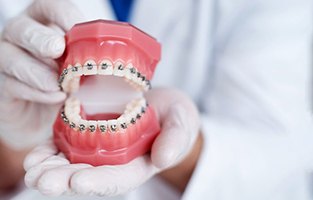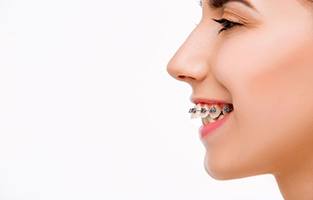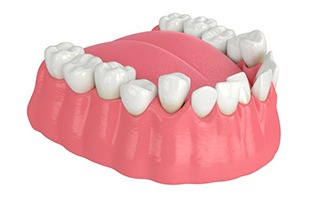Traditional Braces – Bend, OR
The Tried-and-True Path to Straighter Teeth
Traditional braces have helped generations of patients to improve their oral health and feel more confident in the way they look. If you are interested in this tried-and-true path to straighter teeth, the teams at Struble Orthodontics in Bend and Redmond are ready to assist you. Would you like to learn more about what to expect with braces? Continue reading this page, and then contact us when you are ready to book your consultation. We look forward to serving you!
Why Choose Struble Orthodontics for Traditional Braces?
- Highly Skilled Orthodontic Team
- Able to Handle Even Complex Cases
- Consistent, Predictable Results
How Do Traditional Braces Work?

Traditional braces involve the use of metal brackets that get bonded onto the teeth. An arch wire connects those brackets in order to place pressure on the teeth and gradually shift them into their proper positions. As you attend orthodontic checkups every 6 – 8 weeks or so, your braces will be gradually tightened in order to keep your teeth moving toward their goal. The average treatment time with traditional braces is 18 – 36 months.
What Orthodontic Issues Can Braces Fix?

Braces are capable of addressing most types of dental misalignment, from mild cases to severe. During your consultation, we will assess the state of your teeth and let you know for sure whether braces are suitable for your unique circumstances. Here are a few examples of orthodontic issues that we commonly use braces to correct:
Bite Misalignment

Overbite, underbite, crossbite, and open bite are all types of malocclusions (misaligned bite). They can contribute to issues like TMJ disorder, teeth grinding, and more. Braces, usually with the help of special accessories, can adjust the alignment of your teeth and jaws so both your upper and lower teeth can work harmoniously together.
Crowded & Crooked Teeth

Crowded, overlapping teeth may trap food between them, leading to a greatly increased risk of decay, bad breath, and gum disease. Braces are often able to shift the teeth so each one has the space it needs to function optimally. In some cases, one or more teeth must be extracted in order to achieve the best possible results.
Gapped Teeth

Large gaps between the teeth may seem quirky and even cute, but they can leave your gums vulnerable to irritation. Plus, many people feel self-conscious if they have a larger than average space between their front teeth. Braces are often able to shift the teeth closer together so you can enjoy a more functional, more confident smile.
Caring for Your Braces

Properly caring for your braces and your oral health throughout your treatment will require you to make some adjustments to your normal routine. For example, you may need to use special tools to floss around your braces. You will also have to adjust your diet to avoid hard and sticky items that might damage your brackets or wires.
When you visit us for periodic checkups, we can coach you to help you make adjustments that will allow you to maintain a healthy smile and avoid orthodontic emergencies.

